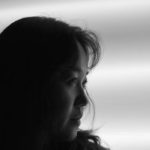
By Fanny Revault
Chiharu Shiota is a Japanese artist born in 1972 in Osaka. Since 1996, she lives and works in Berlin. The artist is represented Templon Gallery.
Where did your passion for art come from?
My parents owned a business manufacturing fish boxes in Osaka. I did not like the life they were living. The factory was always restless. By eight in the morning you could hear the machinery, the employees set to work, and the machines ran until six in the evening, producing a thousand wooden boxes a day.
I knew very early in life that I wanted to pursue art, because I was opposing the life my parents. They were working like machines; I hated this sense of living, I hated the factory itself. I wanted to pursue something more spiritually fulfilling, something that would satisfy me in a spiritual sense. Art was my calling.
How has Occident welcomed you? And your art ?
I never thought much about my Japanese heritage when I lived in Japan. But when I moved to Europe, I was more confronted with my heritage than ever before. I was meeting and working with people from all over the world. And I began to be aware of my cultural identity. However, I also feel trapped by it. When I am exhibiting my art in Europe, I am presented as a Japanese artist; but when I am showing my work in Japan, I am seen as a European artist. I would prefer to be seen as Chiharu Shiota: artist with no tags whatsoever.
What do you feel you are bringing to society through your art? What are the ideas / ideals you defend ?
I am very much fascinated by human communication. It is fascinating how we have developed consciousness and are able to interact with each other but still struggle very much in doing so. We have deep emotional connections with our partners, parents and children but we still have a hard time fully understanding each other. There is still a limited understanding of each other feelings and thoughts. I want to convey this struggle in my installations. I want the viewer to self-reflect on their way of communication when they see the art.

A Key in the Hand, 2015 PAVILLON JAPONAIS, 56ÈME BIENNALE DE VENISE, ITALIE © Chiharu Shiota. Photo Sunhi Mang.

Accumulation: Searching for Destination, 2014-2016 INSTALLATION DE VALISES SUSPENDUES AVEC MOTEURS DIMENSIONS VARIABLES VARIABLE DIMENSIONS VUE DE ART BASEL UNLIMITED 2016 © Chiharu Shiota. Photo Sunhi Mang.

Letters of thanks, 2014 ESPAI, CASTELLÓ, ESPAGNE © Chiharu Shiota. Photo Wanna Filmmakers

House, 2013 INSTALLATION : FILS NOIRS, MAISON EN BOIS, AMPOULE DIMENSIONS VARIABLES DIMENSIONS VARY © Chiharu Shiota. Photo Isabelle Arthuis.

State of Being (Mirror), 2015 ARMATURE EN MÉTAL, MIROIR ET FIL NOIR 93 X 120 X 74,5 CM 36 5/8 X 47 1/4 X 29 3/8 IN. © Chiharu Shiota. Photo Sunhi Mang.

State of Being (Keys), 2015 ARMATURE EN MÉTAL, CLEFS ET FIL ROUGE 148 X 58 X 60 CM 58 1/4 X 22 7/8 X 23 5/8 IN. © Chiharu Shiota. Photo Sunhi Mang.

In Silence, 2002-2013 FILS DE LAINE NOIRE, PIANO À QUEUE ET CHAISES BRÛLÉS DIMENSIONS VARIABLES DIMENSIONS VARY VUE DE ART BASEL UNLIMITED 2013 © Chiharu Shiota. Photo Dirk Wetzel

Infinity, 2011 FILS DE LAINE NOIRE, AMPOULES, ÉLECTRICITÉ / BLACK WOOL THREADS, LIGHT BULBS, ELECTRICITY DIMENSIONS VARIABLES / DIMENSIONS VARY VUE DE L’EXPOSITION « INFINITY », 7 janvier – 18 février 2012, Galerie Daniel Templon, Paris © Chiharu Shiota. Photo B.Huet-Tutti

Night Sky IV, 2017 FIL BLANC SUR TOILE GRISE 200 X 140 CM 78 3/4 X 55 1/8 IN. © Chiharu Shiota. Photo Sunhi Mang.

Sleeping is like death, 2016 FIL NOIR ET LITS EN MÉTAL DIMENSIONS VARIABLES VARIABLE DIMENSIONS VUE DE L’EXPOSITION « SLEEPING IS LIKE DEATH », Galerie Daniel Templon Bruxelles, 14 janvier – 20 février 2016 © Chiharu Shiota. Photo Isabelle Arthuis.

Portrait de Chiharu Shiota. Photo Sunhi Mang.


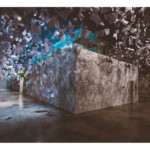

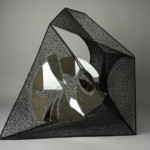

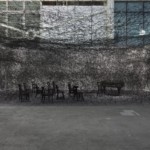

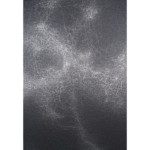
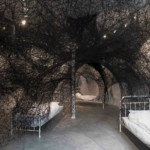

Who is your favorite artist? Is there an artist you feel connected to ?
I admire Ana Mendieta very much. She has influenced me ever since I started studying art in Japan. I feel very connected to her work and the concept of connecting the body with the universe.
Why do you think art is important in our lives?
Through art we can reflect on our selves more. A picture, a drawing and art in general can often express more than words can. It is a sense of expression that will help other people understand themselves and others better.
What experiences marked you the most?
In 2005, I was diagnosed with ovarian cancer; this influenced my art very much. Before I was diagnosed, I wasn’t painting anymore ; but afterwards I was painting again and creating new art.
According to you, where is the actual art in an artist’s work?
This is a very easy question to ask but a difficult one to answer. I don’t think I am able to answer this question, I think that is why I create art.
Portrait de Chiharu Shiota. Photo Sunhi Mang.

